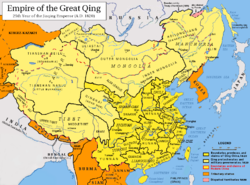
Back نظام الروافد في الصين Arabic Čínský tributární systém Czech سیستم باجگذاری چین FA Système tributaire de la Chine French Sistem upeti Tiongkok ID Sistema tributario della Cina imperiale Italian 冊封体制 Japanese 책봉체제 Korean Chinees tribuutsysteem Dutch Det kinesiske tributtsystemet NB


The tributary system of China (simplified Chinese: 中华朝贡体系, traditional Chinese: 中華朝貢體系, pinyin: Zhōnghuá cháogòng tǐxì), or Cefeng system (simplified Chinese: 册封体制; traditional Chinese: 冊封體制; pinyin: Cèfēng tǐzhì) at its height was a network of loose international relations centered around China which facilitated trade and foreign relations by acknowledging China's hegemonic role within a Sinocentric world order. It involved multiple relationships of trade, military force, diplomacy and ritual. The other states had to send a tributary envoy to China on schedule, who would kowtow to the Chinese emperor as a form of tribute, and acknowledge his superiority and precedence. The other countries followed China's formal ritual in order to keep the peace with the more powerful neighbor and be eligible for diplomatic or military help under certain conditions. Political actors within the tributary system were largely autonomous and in almost all cases virtually independent.[1]
Scholars differ on the nature of China's relations with its neighbors in traditional times. Many describe a system that embodied a collection of institutions, social and diplomatic conventions, and institutions that dominated China's contacts with the non-Chinese world for two millennia, until the collapse of the system around the end of the 19th century.[2] Other scholars like Odd Arne Westad see a variety of relationships that differed in character, not an overall "tributary system". They suggest a Sinocentric system, in which Chinese culture was central to the self-identification of many elite groups in the surrounding Asian countries.[3] By the late 19th century, China had become part of a European-style community of sovereign states and established diplomatic relations with other countries in the world following international law.[4] While some scholars have suggested that the tributary system is a model for understanding international relations in East Asia today, other scholars have argued that the concept is misleading about relations in both early modern times and today.[5]
| Tributary system of China | |||||||||
|---|---|---|---|---|---|---|---|---|---|
| Traditional Chinese | 中華朝貢體系 | ||||||||
| Simplified Chinese | 中华朝贡体系 | ||||||||
| |||||||||
- ^ ChuLiu 1994, p. 177.
- ^ Zhang, Yongjin, "The Tribute System", Oxford Bibliographies, retrieved September 27, 2023
- ^ Westad (2012), p. 10.
- ^ Rowe, William (2010). China's Last Empire - The Great Qing. Harvard University Press. p. 211. ISBN 9780674054554. Retrieved September 27, 2023.
- ^ Perdue (2015), p. 1002.